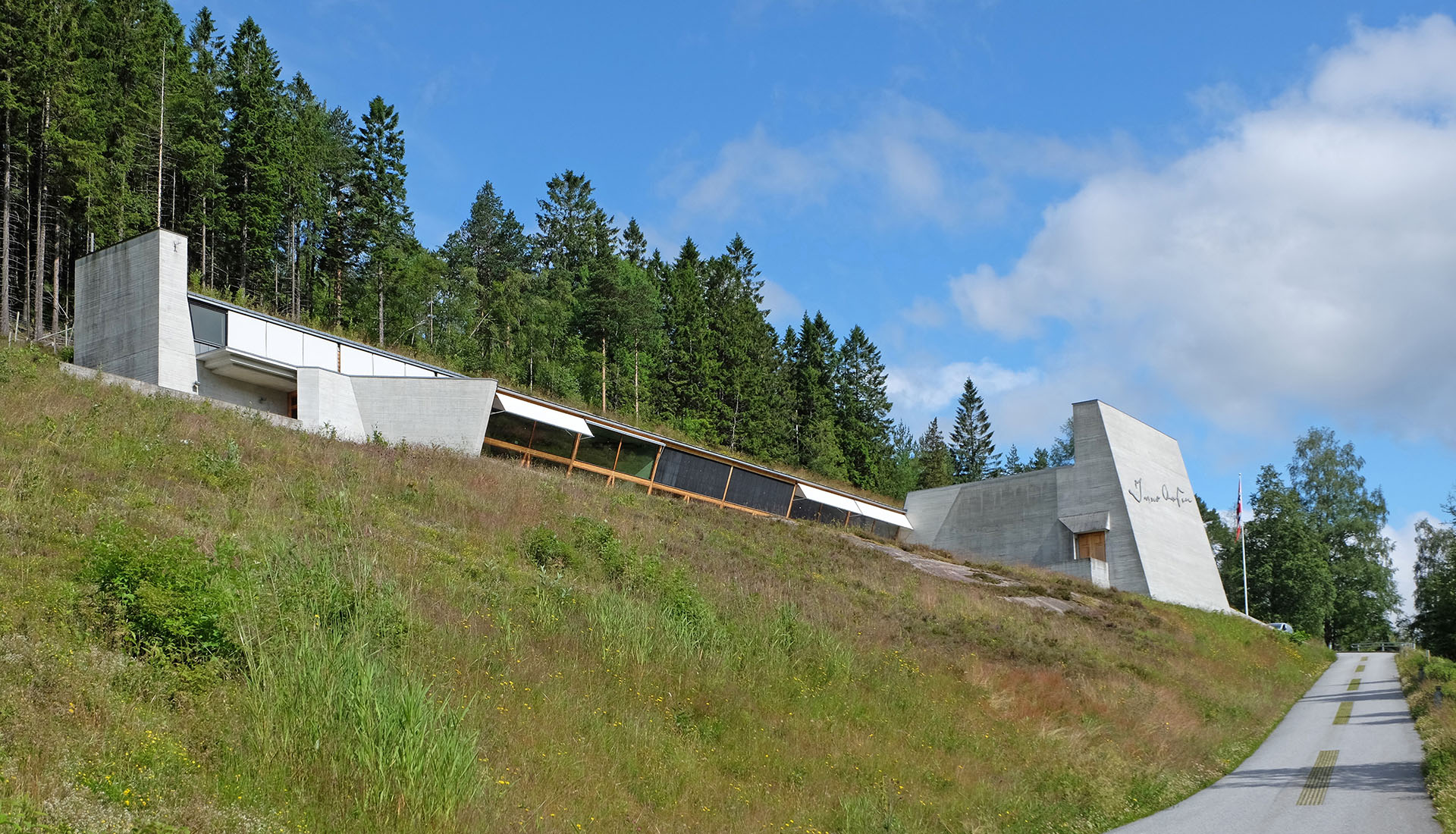 |
 |
 |
 |

Ivar Aasen Centre
Indrehovdevegen 176, Orsta
1996 - 2000
The
Ivar Aasen Centre documents the life and work of the linguist and poet
of the same name and at the same time also houses a cultural center for
the New Norwegian language, called Nynorsk. This language was
constructed in the late 19th century by Ivar Aasen, based on his
studies of rural Norwegian linguistics. For the institution a parcel in
the immediate vicinity of Ivar Aasen's birthplace was chosen. Sverre Fehn received
the commission for the design of the Ivar Aasen Center from the
Norwegian Minister of Culture Åse Kleveland as a honorary assignment.
The plot shows a dramatic hillside, and Sverre Fehn's design is to be
regarded as a response to the topography. Especially since the
building, which was completed in 2000, is partially buried into the
hillside. As a consequence a dominant façade towards the valley
resulted. Accordingly a strong tension between architectural design and
program was created. The external appearance of the building is
dominated by bright concrete and generous glazing. The towering back
wall of the auditorium constitutes the face of the building to the
valley. On the inclined concrete elevation the Ivar Aasen signature was
mounted in steel letters. The building is entered through a vast arched
structure which grows from the slope-side retaining wall and continues
into the forecourt. Next to the entrance are arranged the restaurant
and the reception of the museum. With orientation to the valley are
arranged the rooms dedicated to the life and work of Ivar Aasen. The
individual rooms are suspended between inclined wall slabs and open to
the landscape through generous glazings. The individual spaces are
assigned to the different stages in the life of the linguist. Along the
retaining wall unfolds a series of rooms with chamber-like spaces,
which are illuminated from above. At the end of this sequence of rooms
is to be found the large library, which extends over two floors and
connects directly to the level of research and administration. The
elongated and partially buried building wing is preceded by the
mentioned auditorium, which follows the topography of the site and
provides access to both levels.
Das Ivar Aasen-Zentrum dokumentiert das Leben und Werk des Sprachforschers und Dichters und beherbergt gleichzeitig ein Kulturzentrum für die Neunorwegische Sprache, das sogenannte Nynorsk. Diese Sparche wurde im späten 19. Jahrhundert von Ivar Aasen konstruiert, basierend auf seinen Studien der ländlichen norwegischen Linguistik. Für die Institution wurde ein Gelände in unmittelbarer Nähe zum Geburtshaus Ivar Aasen's gewählt. Den Auftrag für den Entwurf des Ivar Aasen Zentrum erhielt Sverre Fehn vom norwegischen Kulturminister Åse Kleveland als Ehrenaufgabe. Das Grundstück zeigt eine dramatische Hanglage, und Sverre Fehns Entwurf ist als Antwort auf die Topographie zu betrachten. Zumal das Gebäude, welches im Jahr 2000 fertiggestellt wurde, teilweise in den Hang eingegraben wurde, entstand eine dominante Fassade zum Tal. Entsprechend wurde eine starke Spannung zwischen architektonischer Konstruktion und dem Programm der Benutzer erzeugt. Die äussere Erscheinung des Gebäudes wird dominiert vom hellen Beton und grosszügigen Verglasungen. Das eigentliche Gesicht des Bauwerks bildet die hoch aufragende Rückwand des Auditoriums. Auf der geneigten Sichtbetonfläche wurde die Signatur Ivar Aasens in Stahl angebracht. Das Gebäude betritt man über eine grosse Gewölbekonstruktion, welche aus der hangseitigen Stützmauer wächst und sich im Vorbereich fortsetzt. Direkt beim Eingang befinden sich das Restaurant und der Empfang zum Museum. Mit Orientierung zum Tal sind die Räume angeordnet, welche dem Leben und Werk Ivar Aasens gewidmet sind. Dabei sind die einzelnen Räume zwischen schräge Wandscheiben eingehängt und öffnen sich mittels grosszügiger Verglasungen zur Landschaft. Die einzelnen Räuem sind den unterschiedlichen Phasen im Leben des Sprachforschers zugeordnet. Entlang der Stützmauer entfaltet sich eine Raumfolge mit kammerartigen Räumen, welche von oben belichtet werden. Am Ende dieser Raumfolge befindet sich der grosse Bibliotheksraum, welcher sich über zwei Geschosse erstreckt und direkt an die Ebene für Forschung und Verwaltung anschliesst. Dem langgestreckten und teilweise eingegrabenen Gebäuderiegel ist Auditorium vorgelagert, welches der Topographie des Geländes folgt und Zugang zu beiden Ebenen gewährt.
Das Ivar Aasen-Zentrum dokumentiert das Leben und Werk des Sprachforschers und Dichters und beherbergt gleichzeitig ein Kulturzentrum für die Neunorwegische Sprache, das sogenannte Nynorsk. Diese Sparche wurde im späten 19. Jahrhundert von Ivar Aasen konstruiert, basierend auf seinen Studien der ländlichen norwegischen Linguistik. Für die Institution wurde ein Gelände in unmittelbarer Nähe zum Geburtshaus Ivar Aasen's gewählt. Den Auftrag für den Entwurf des Ivar Aasen Zentrum erhielt Sverre Fehn vom norwegischen Kulturminister Åse Kleveland als Ehrenaufgabe. Das Grundstück zeigt eine dramatische Hanglage, und Sverre Fehns Entwurf ist als Antwort auf die Topographie zu betrachten. Zumal das Gebäude, welches im Jahr 2000 fertiggestellt wurde, teilweise in den Hang eingegraben wurde, entstand eine dominante Fassade zum Tal. Entsprechend wurde eine starke Spannung zwischen architektonischer Konstruktion und dem Programm der Benutzer erzeugt. Die äussere Erscheinung des Gebäudes wird dominiert vom hellen Beton und grosszügigen Verglasungen. Das eigentliche Gesicht des Bauwerks bildet die hoch aufragende Rückwand des Auditoriums. Auf der geneigten Sichtbetonfläche wurde die Signatur Ivar Aasens in Stahl angebracht. Das Gebäude betritt man über eine grosse Gewölbekonstruktion, welche aus der hangseitigen Stützmauer wächst und sich im Vorbereich fortsetzt. Direkt beim Eingang befinden sich das Restaurant und der Empfang zum Museum. Mit Orientierung zum Tal sind die Räume angeordnet, welche dem Leben und Werk Ivar Aasens gewidmet sind. Dabei sind die einzelnen Räume zwischen schräge Wandscheiben eingehängt und öffnen sich mittels grosszügiger Verglasungen zur Landschaft. Die einzelnen Räuem sind den unterschiedlichen Phasen im Leben des Sprachforschers zugeordnet. Entlang der Stützmauer entfaltet sich eine Raumfolge mit kammerartigen Räumen, welche von oben belichtet werden. Am Ende dieser Raumfolge befindet sich der grosse Bibliotheksraum, welcher sich über zwei Geschosse erstreckt und direkt an die Ebene für Forschung und Verwaltung anschliesst. Dem langgestreckten und teilweise eingegrabenen Gebäuderiegel ist Auditorium vorgelagert, welches der Topographie des Geländes folgt und Zugang zu beiden Ebenen gewährt.
